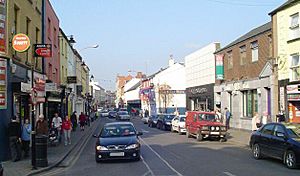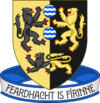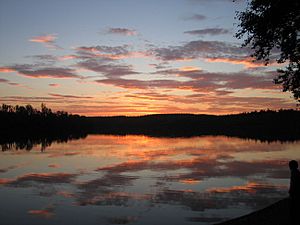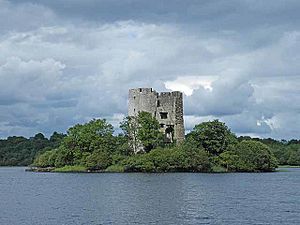County Cavan facts for kids
Quick facts for kids
County Cavan
Contae an Chabháin
|
||
|---|---|---|
|
||
| Nickname(s):
The Breffni County
|
||
| Motto(s):
Irish: Feardhacht is Fírinne
"Manliness and Truth" |
||
 |
||
| Country | Ireland | |
| Province | Ulster | |
| Region | Northern and Western | |
| Established | 21 August 1579 | |
| County town | Cavan | |
| Area | ||
| • Total | 1,932 km2 (746 sq mi) | |
| Area rank | 19th | |
| Highest elevation
(Cuilcagh)
|
665 m (2,182 ft) | |
| Population
(2022)
|
||
| • Total | 81,704 | |
| • Rank | 25th | |
| • Density | 42.290/km2 (109.530/sq mi) | |
| Time zone | UTC±0 (WET) | |
| • Summer (DST) | UTC+1 (IST) | |
| Eircode routing keys |
A82, H12, H14, H16 (primarily)
|
|
| Telephone area codes | 042, 049 (primarily) | |
| ISO 3166 code | IE-CN | |
| Vehicle index mark code |
CN | |
County Cavan (pronounced KAV-ən; Irish: Contae an Chabháin) is a beautiful county located in the Republic of Ireland. It is part of the Ulster province and is known for its many lakes and green hills. The county is named after Cavan, its main town, and is often called 'The Breffni County'. This nickname comes from its historical connection to the ancient Gaelic territory of East Breffny. Cavan County Council is in charge of local services. According to the 2022 census, about 81,704 people live in County Cavan.
Contents
- Exploring County Cavan's Geography
- County Cavan's Divisions and Towns
- A Glimpse into Cavan's History
- How County Cavan is Governed
- Fun Places to Visit in County Cavan
- Getting Around County Cavan
- Sports and Activities in County Cavan
- People and Culture of County Cavan
- Cavan's Economy and Industries
- Famous Faces from County Cavan
- See also
Exploring County Cavan's Geography
Cavan shares its borders with six other counties. To the west is County Leitrim, to the north is County Fermanagh, and to the north-east is County Monaghan. County Meath is to the south-east, County Longford to the south-west, and County Westmeath to the south. A 70-kilometer border connects Cavan with County Fermanagh in Northern Ireland. Cavan is the 19th largest county in Ireland by land area and the 25th largest by population.
The county's landscape is famous for its drumlins, which are small, oval-shaped hills left behind by glaciers. These hills are scattered among many sparkling lakes. The north-western part of Cavan is more mountainous and has fewer people. The highest point in the county is Cuilcagh mountain, standing at 665 meters tall.
Rivers and Lakes: The Lakeland County
Cavan is the starting point for several important rivers. The River Shannon, Ireland's longest river, begins at a place called Shannon Pot on the slopes of Cuilcagh mountain. The River Erne, another major river, starts from Beaghy Lough near Stradone and flows for 120 kilometers. Other rivers include the Blackwater River, the Dee, the River Annalee, and the Cladagh.
Cavan is proudly known as 'The Lakeland County' because it's said to have 365 lakes – one for every day of the year! Lough Sheelin is the largest lake in the county, covering 18.8 square kilometers. It forms a border between Cavan, Meath, and Westmeath. Many lakes in the north and west, like Lough Oughter, are protected areas for wildlife. Other important lakes include Lough Gowna and Lough Ramor.
Forests and Green Spaces
Even with all its lakes, Cavan also has nearly 7,000 hectares of forested land. This makes up about 3.6% of the county's total area. You can explore beautiful forests such as Bellamont Forest near Cootehill, Killykeen Forest Park at Lough Oughter, Dún na Rí Forest Park, and the Burren Forest.
Cavan's Climate: What to Expect
| Weather chart for Ballyhaise, Cavan | |||||||||||||||||||||||||||||||||||||||||||||||
|---|---|---|---|---|---|---|---|---|---|---|---|---|---|---|---|---|---|---|---|---|---|---|---|---|---|---|---|---|---|---|---|---|---|---|---|---|---|---|---|---|---|---|---|---|---|---|---|
| J | F | M | A | M | J | J | A | S | O | N | D | ||||||||||||||||||||||||||||||||||||
|
78
8
2
|
68
8
2
|
66
10
3
|
58
12
4
|
57
15
6
|
57
17
11
|
59
19
12
|
89
19
12
|
58
16
9
|
98
13
6
|
68
9
3
|
76
8
3
|
||||||||||||||||||||||||||||||||||||
| temperatures in °C precipitation totals in mm |
|||||||||||||||||||||||||||||||||||||||||||||||
|
Imperial conversion
|
|||||||||||||||||||||||||||||||||||||||||||||||
The weather in Cavan is generally mild, with cool winters and pleasant, humid summers. It doesn't usually get extremely hot or cold. The warmest month is typically July, with average maximum temperatures around 19.8°C. January is usually the coldest, with average maximum temperatures around 8.2°C.
Rainfall is spread throughout the year, but October tends to be the wettest month. May and June are often the driest and sunniest. Snow showers can happen between November and March. In December 2010, Cavan experienced its lowest recorded temperature, dropping to -15.4°C. Summer temperatures usually stay between 15°C and 22°C.
County Cavan's Divisions and Towns
Historic Baronies
Cavan is divided into eight historic areas called baronies. While these divisions are very old, they are still officially recognized.
- Castlerahan (Caisleán Raithin)
- Clankee (Clann Chaoich)
- Clanmahon (Clann Mhathúna)
- Loughtee Lower (Lucht Tí Íochtarach)
- Loughtee Upper (Lucht Tí Uachtarach) – where Cavan town is located
- Tullygarvey (Teallach Ghairbhíth)
- Tullyhaw (Teallach Eathach) – the largest barony
- Tullyhunco (Teallach Dhúnchadha)
Towns and Villages to Visit
Cavan has many towns and villages, each with its own charm.
- Arvagh
- Bailieborough
- Ballinagh
- Ballyconnell
- Ballyhaise
- Ballyjamesduff
- Bawnboy
- Belturbet
- Blacklion
- Butlersbridge
- Canningstown
- Cavan
- Cootehill
- Crossdoney
- Dowra
- Glangevlin
- Kilcogy
- Killeshandra
- Kilnaleck
- Kingscourt
- Lough Gowna
- Milltown
- Mountnugent
- Mullagh
- Redhills
- Shercock
- Stradone
- Swanlinbar
- Virginia
Largest Towns by Population (2022)
Here are the biggest towns in County Cavan based on the 2022 census:
- Cavan – 11,741 people
- Virginia – 3,211 people
- Bailieborough – 2,974 people
- Kingscourt – 2,955 people
- Ballyjamesduff – 2,917 people
- Cootehill – 1,856 people
- Mullagh – 1,651 people
- Belturbet – 1,610 people
- Ballyconnell – 1,422 people
A Glimpse into Cavan's History
For a long time, starting around the 13th century, the area of Cavan was part of a small kingdom called East Bréifne. This kingdom was ruled by the O'Reilly family, which is why the county is still known as the Breffni County today. The natural landscape, with its drumlin hills and lakes, helped protect the area from invaders.
Around the late 12th century, the Normans arrived and built fortifications like Clogh Oughter castle. Monasteries also became important, with remains still visible in places like Drumlane. In 1584, during the time of Queen Elizabeth I, County Cavan was officially formed and became part of the province of Ulster.
Later, in the 17th century, a plan called the Plantation of Ulster brought new settlers to the county. This led to the creation of towns like Bailieborough, Cootehill, Killeshandra, and Virginia. Older towns like Cavan and Belturbet grew into important trading centers. These new settlements also brought better farming methods and helped the flax and linen industry begin to thrive.
Some areas of Cavan faced great challenges during the Great Famine between 1845 and 1849. Many people suffered, and there were sad times with illnesses and families losing their homes. A famous song, "By Lough Sheelin Side," tells a story from this difficult period.
How County Cavan is Governed
Local Government and Community Services
Cavan County Council is the local authority that manages services for the county. This includes things like roads, housing, and environmental protection. The county is divided into three local electoral areas: Bailieborough-Cootehill, Ballyjamesduff-Virginia, and Cavan-Belturbet. These areas elect 18 representatives to the county council. In the 2019 local elections, the main political parties that won seats were Fianna Fáil and Fine Gael, along with some independent councillors.
National and European Representation
For national elections, County Cavan is part of the Cavan–Monaghan constituency, which elects five members to the Dáil Éireann (Ireland's parliament). For elections to the European Parliament, Cavan is part of the Midlands–North-West constituency.
Fun Places to Visit in County Cavan
Historical Sites and Museums
- Cabra Castle: A beautiful castle with a long history.
- Castle Saunderson: Another historic castle.
- Cathedral of Saint Patrick and Saint Felim: A grand church in Cavan town.
- Cavan County Museum: A great place to learn about the county's past.
- Cloughoughter Castle: A striking castle ruin on an island in a lake.
- Drumlane Monastery: Remains of an ancient monastery.
- Saint Kilian Heritage Centre: Dedicated to a famous saint born in Mullagh.
Natural Wonders and Parks
- Cuilcagh: The highest mountain in the county, offering great views.
- Dún na Rí Forest Park: A lovely forest park for walks and nature.
- Killykeen Forest Park: A Coillte forest park located by Lough Oughter.
- Lough Sheelin: The county's largest lake, perfect for fishing.
- Marble Arch Caves Global Geopark: A fascinating area with caves and unique landscapes.
- Shannon-Erne Waterway: A beautiful waterway for boating and enjoying nature.
Getting Around County Cavan
Road Travel
Two main national roads cross Cavan: the N3 and the N16. The N3 is the longest, stretching 60 kilometers through the county. Other important roads include the N87, N54, and N55. Bus Éireann provides bus services connecting villages and towns, including a direct route to Dublin Airport.
Railways: A Look Back
In the mid-1800s, railways came to Cavan, connecting towns like Cavan and Belturbet to other parts of Ireland. These railways were very important for moving people and goods, and they even helped the sport of GAA grow by making it easier for fans to travel. However, after World War II, many railway lines were closed. By 1959, all train services in Cavan had stopped. Today, you can visit Belturbet railway station, which is now a railway museum.
Waterways for Leisure
Historically, water transport was very important in Cavan due to its many lakes and rivers. Today, these waterways are mainly used for fun activities like boating on the River Erne and Shannon-Erne Waterway, and for angling.
Sports and Activities in County Cavan
Gaelic football is the most popular sport in County Cavan. The Cavan GAA team has won the All-Ireland Senior Football Championship five times! They currently play in Division 2 of the National Football League.
Cavan also has a senior hurling team, which was reformed in 2017. They compete in Division 3B of the National Hurling League and in the Lory Meagher Cup. The first GAA club in Cavan was founded in Ballyconnell in 1885. The most successful club is Cornafean, with 20 Senior Football Championship titles.
There are several athletics clubs and facilities, including a 300-meter track in Shercock. Rugby is also played, with clubs like County Cavan R.F.C. and Virginia R.F.C. And, of course, with so many lakes and rivers, Fishing is a very popular activity!
Here are some of the sports clubs in Cavan:
| Club | Sport | League |
|---|---|---|
| Cavan Gaels GAA | Gaelic Football | Cavan Senior Football Championship |
| Killinkere | Basketball | North East League |
| Bailieboro Celtic FC | Association football | Meath & District League |
| Mullahoran | Hurling | Cavan Senior Hurling Championship |
| County Cavan R.F.C. | Rugby | Ulster Rugby |
| Bailieborough AC | Athletics | Cavan County Championships |
| Cornafean GAA | Gaelic football | Cavan Junior Football Championship |
People and Culture of County Cavan
Population and Backgrounds
As of 2022, County Cavan has a population of 81,704 people. Besides people from Ireland, many residents come from other countries, with the most common non-Irish nationalities being from the UK, Poland, and Lithuania.
Religious Life in Cavan
The 2016 census showed that most people in Cavan, about 82%, identify as Roman Catholic. Other religions make up about 11% of the population, and about 5% said they didn't follow a religion.
You can find many places of worship in Cavan. The Cathedral of Saint Patrick and Saint Felim is the main Roman Catholic church. St Fethlimidh's Cathedral is a Church of Ireland cathedral. There are also a Baptist Church, an Islamic Cultural Centre (used as a mosque), Methodist churches, and Presbyterian churches throughout the county.
Cavan's Economy and Industries

Agriculture is the biggest industry in County Cavan. Farmers here focus a lot on dairy milk, as well as raising pigs and beef cattle. The county's clay soils are rich in minerals, making them great for pasture farming. There are over 144,000 hectares of farmed land and about 219,568 cattle in Cavan. Lakeland Dairies Group, based in Killeshandra, is one of Ireland's largest dairy companies.
Cavan is also a leader in pig production, with its farms raising a significant portion of Ireland's pigs. Beyond farming, other important industries include quarrying, energy production, and manufacturing. For example, the Quinn cement facility is located in Ballyconnell. The county also produces wind energy from nine wind farms, and peat is cut in the north-west.
Famous Faces from County Cavan
Many interesting people have come from County Cavan:
- Gerard Beirne – a talented writer.
- Henry Brooke and Charlotte Brooke – also well-known writers.
- Dallán Forgaill – an early Christian poet.
- Marcus Daly – an American businessman known as one of the "Copper Kings."
- Thomas "Broken-Hand" Fitzpatrick – a famous American frontiersman.
- Michael Harding – a modern writer.
- Saint Kilian – a missionary and martyr born in Mullagh.
- Leona Maguire – a professional golfer.
- Neven Maguire – a famous chef and TV personality from Blacklion.
- Patrick O'Rorke – a US Union Army colonel who fought at Gettysburg.
- Mary Anne Sadlier – a writer.
- Brendan Smith TD – a former government minister.
See also
 In Spanish: Condado de Cavan para niños
In Spanish: Condado de Cavan para niños
- List of abbeys and priories in Ireland (County Cavan)
- Lord Lieutenant of Cavan
- High Sheriff of Cavan
- Ralaghan Man




